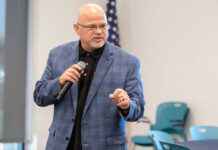
Public transportation provides an arterial network within a community that creates the ability for its citizens to circulate commerce. It is agreed that there is benefit to such a program, but supporting such a program isn’t as easy as a quick yes or no. Transportation programs can be expensive, and balance between what services are needed and what is fiscally viable must be reached.
As we look to the future, and the city continues to grow, Maricopa will need to continuously re-evaluate its transportation needs. Can the program work? Yes, I believe it can, but what many don’t know is that the current grant is designed to provide assistance to rural communities where the population is less than 50,000. It’ll be a few years before Maricopa hits this number, but, as the population grows, federal grant money will either decrease, or the city will be competing with other municipalities for its share of funds.
This brings to light one of the reasons why the 2010 Census is so important. The census won’t only give us a better idea on where our population is today, but it’ll help the city more accurately predict its growth rate and needs for future transportation expansion. The grant system assumes a higher population will result in increased ridership, thus increasing operational revenue and a lower dependence on federal funds.
Some important points:
1. We should be taking every step possible to ensure we keep federal grant funds and our local matching tax dollars in the local community, by hiring local service providers, or at least those within our regional area. We should be able to stimulate our own local economy and provide employment opportunities to our residents.
2. Future infrastructure improvements to the city should incorporate any potential growth of our public transportation program. An example of this would be planned space for bus drop-off/pick-up points, covered bus stops and crosswalks.
3. The city should continue to research methods to be used as a catalyst to offset the cost to our taxpayers. One idea is advertising.
4. The system should predominantly serve our local community and provide regional service, or connection to regional services, that will deliver riders to the downtown Phoenix area.
There are those who would propose that providing public transportation is the responsibility of your government, and that it should be viewed as a minimum expectation of services, such as police and fire, but the reality is that the viability of our local transit system is based on the local taxpayer’s willingness to pay the bill.
So, as Maricopa begins its recovery from the current downturn in the economy, and again heads towards positive growth, it’ll need to posture itself to ensure its flexibility on the “balancing act” that comes with providing public transportation that is cost effective, responsible and meets the needs of our growing community.
Alan Marchione
Alan Marchione is a candidate for Maricopa City Council. (www.marchione2010.com)
Submitted photo








![Maricopa restaurateur makes Food Network connection [Namkeen Dhaba]](https://www.inmaricopa.com/wp-content/uploads/2024/04/439456716_377105198650519_7536248579664805896_n-218x150.jpg)

![Merging lanes incite more 347 anger A merging lane sign sits on the side of State Route 347 northbound lanes during evening traffic on April 30, 2024. [Monica D. Spencer]](https://www.inmaricopa.com/wp-content/uploads/2024/04/spencer-043024-adot-merging-lanes-347-web-218x150.jpg)




